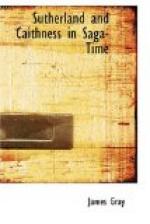Of this third line of De Moravias or Morays, two distinct branches settled north of the Oykel. First, we have Hugo Freskyn, son, it is said, but, as we shall see, really grandson, of the original Freskyn and son of Freskyn’s elder or eldest son William.[26] This William no doubt fought for, and may, or may not, have held land in Sutherland, but his son Hugo certainly had all Sutherland properly so called, that is, Sudrland, or the Southland of Caithness comprising the parishes of Creich, Dornoch, Rogart, Kilmalie (afterwards Golspie), Clyne, Loth, and most of Lairg and Kildonan,[27] formally granted to him, and he held also the Duffus Estates in Moray, by sea only thirty miles south of Dunrobin.
The second branch was that of the younger Freskin de Moravia, great-great-grandson of the original Freskyn,[28] and ancestor of the Lords of Duffus, who obtained lands, which were mainly in modern Caithness, and also in the upper portion of the valley of the Naver and the valley of Coire-na-fearn in Strathnavern, by marriage with the Lady Johanna of Strathnaver about 1250.[29] This latter portion was immediately north of the land granted to Hugo Freskyn; and the Caithness portion of Johanna’s lands marched with Hugo’s land on its eastern boundary. Nor must we forget that a large area of the modern county of Sutherland, consisting of part of the present parishes of Eddrachilles and Durness and some part of Tongue and Farr in Strathnavern, was constantly used as a refuge by Pictish refugees of the race of MacHeth or MacAoidh, displaced and frequently driven forth from Moray after the bloody defeat of Stracathro in 1130 and in later rebellions as part of the policy of the Scottish kings, and first known as the race of Morgan and then to us as the Clan Mackay.
They chose, indeed, for their refuge and ultimately for their settlements a rugged and sterile land, to which their original title was no charter, but their swords. Difficulties, it is said, make character, and nowhere is this proverbial saying better illustrated and proved than in the Reay country by its men and women. They have given their own and other countries many fine regiments and distinguished generals and statesmen, and none more so than the late Lord Reay. Their history is to be found in the Book of Mackay, a piece of good pioneer work from original documents by the late Mr. Angus Mackay, and also in his unfortunately unfinished Province of Cat.
Yet another family, of Norse and Viking lineage, which was settled in Orkney from the earliest Norse times and afterwards in Caithness and Sutherland, was that of the Gunns, who were descended in the male line from Sweyn Asleifarson the great Viking, and on the female side from the line of Paul, and later were by marriage connected with the Moddan clan and with the line of Erlend. They have for nine centuries lived and still live in Sutherland and Caithness, and have been noted alike for the beauty of their women, and for the high attainments and character and the distinction of their men, particularly in the art of war, both by land and sea.




